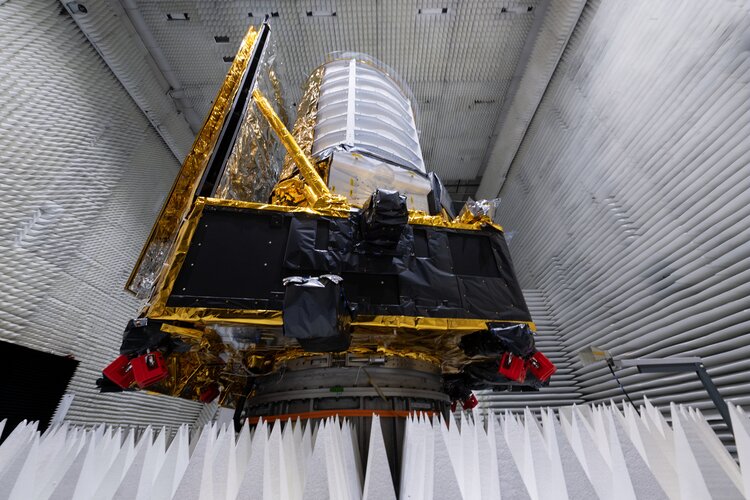
Image:
ESA’s Euclid mission is undergoing the final test before launch in July 2023.
Here it is standing in a special room in the Thales Alenia Space test facilities in Cannes, France, where it successfully underwent electromagnetic compatibility testing.
This kind of testing is routine for spacecraft. All electronics emit some form of electromagnetic waves that can cause interference with other devices. Think of the buzz that speakers give out right before an incoming call on a mobile phone. Spacecraft electronics can cause similar interference, but out in space such interference can have disastrous consequences, so all systems must be checked before launch.
The large test chamber at TAS, called the Compact Antenna Test Range, simulates the electromagnetic environment of deep space, being lined with cones that absorb radio signals and prevent reflections. To avoid TV or radio interference, the walls of the chamber form a steel ‘Faraday cage’, impenetrable to electromagnetic signals from the outside world.
In this radiation-free environment, the team studied the radio signals and electrical noise coming from the various systems on the spacecraft and checked whether they caused any electromagnetic interference with each other.
ESA’s Euclid mission is designed to explore the composition and evolution of the dark Universe. The space telescope will create a great map of the large-scale structure of the Universe across space and time by observing billions of galaxies out to 10 billion light-years, across more than a third of the sky. Euclid will explore how the Universe has expanded and how structure has formed over cosmic history, revealing more about the role of gravity and the nature of dark energy and dark matter.
Euclid is a fully European mission, built and operated by ESA, with contributions from NASA. The Euclid Consortium – consisting of more than 2000 scientists from 300 institutes in 13 European countries, the US, Canada and Japan – provided the scientific instruments and scientific data analysis. ESA selected Thales Alenia Space as prime contractor for the construction of the satellite and its Service Module, with Airbus Defence and Space chosen to develop the Payload Module, including the telescope. NASA provided the near-infrared detectors of the NISP instrument.
Click here for original story, Euclid electromagnetic compatibility tests successful
Source: ESA Space News